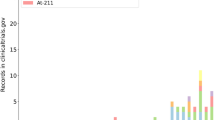Background:
Dose response experiments aim to determine the complication probability as a function of dose. Adjusting the parameters of the frequently used dose response model P(D) = 1/[1 + (D50/D)k] to the experimental data, 2 intuitive quantities are obtained: the tolerance dose D50 and the slope parameter k. For mathematical reasons, however, standard statistic software uses a different set of parameters. Therefore, the resulting fit paramters of the statistic software as well as their standard errors have to be transformed to obtain D50 and k as well as their standard errors.
Material and Methods: The influence of the number of dose levels on the uncertainty of the fit parameters is studied by a simulation for a fixed number of animals. For experiments with small animal numbers, statistical artifacts may prevent the determination of the standard errors of the fit parameters. Consequences on the design of dose response experiments are investigated.
Results: Explicit formulas are presented, which allow to calculate the parameters D50 and k as well as their standard errors from the output of standard statistic software. The simulation shows, that the standard errors of the resulting parameters are independent of the number of dose levels, as long as the total number of animals involved in the experiment, remains constant.
Conclusion: Statistical artifacts in experiments containing small animal numbers may be prevented by an adequate design of the experiment. For this, it is suggested to select a higher number of dose levels, rather than using a higher number of animals per dose level.
Hintergrund:
Dosis-Wirkungs-Experimente bestimmen die Komplikationswahrscheinlichkeit als Funktion der Dosis. Werden die Parameter des häufig verwendeten Modells P(D) = 1/[1 + (D50/D)7k] an die Daten angepasst; ergeben sich zwei intuitive Größen: die Toleranzdosis D50 und der Steigungsparameter k (Abbildung 1). Aus mathematischen Gründen verwenden Statistikprogramme jedoch eine andere Parametrisierung. Daher müssen die Ausgabeparameter des Statistikprogramms in die Parameter D50 und k und ihre Standardfehler umgerechnet werden.
Material und Methodik: Durch eine Simulation wird der Einfluss der Anzahl Dosispunkte bei konstanter Tierzahl auf die Größe des Standardfehlers der Fit-Parameter D50 und k untersucht. Bei kleinen Tierzahlen können statistische Artefakte auftreten, die eine Bestimmung der Standardfehler der Fit-Parameter verhindern. Konsequenzen für das Design des Experiments werden untersucht.
Ergebnisse: Es werden Formeln angegeben, die eine Berechnung der Parameter D50, k sowie deren Standardfehler aus den Ausgabeparametern von Statistikprogrammen erlauben. Die Simulation der Standardfehler der Fit-Parameter zeigt, dass dieser unabhängig von der Zahl der Dosispunkte und der Zahl der Tiere pro Dosispunkt ist, wenn die Gesamttierzahl konstant gehalten wird (Abbildung 2).
Schlussfolgerung: Statistische Artefakte in Dosis-Wirkungs-Experimenten, die eine Fehlerbestimmung der Fit-Parameter verhindern, können durch ein geeignetes Design des Experiments vermieden werden. Dazu sollte eine größere Anzahl von Dosispunkten einer höheren Tierzahl pro Dosispunkt vorgezogen werden.
Similar content being viewed by others
Author information
Authors and Affiliations
Additional information
Submitted: 9 Aug 2000; accepted: 13 Oct 2000.
Rights and permissions
About this article
Cite this article
Karger, C., Hartmann, G. Determination of Tolerance Dose Uncertainties and Optimal Design of Dose Response Experiments with Small Animal Numbers. Strahlenther Onkol 177, 37–42 (2001). https://doi.org/10.1007/PL00002356
Issue Date:
DOI: https://doi.org/10.1007/PL00002356




